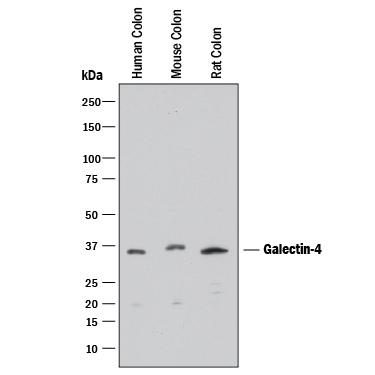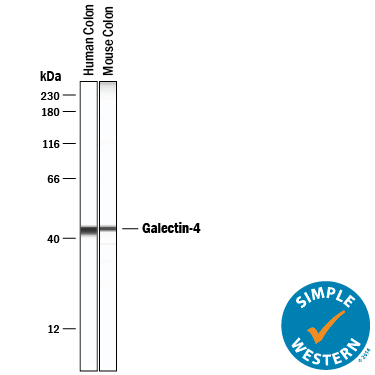Human/Mouse/Rat Galectin-4 Antibody Summary
Applications
Please Note: Optimal dilutions should be determined by each laboratory for each application. General Protocols are available in the Technical Information section on our website.
Scientific Data
 View Larger
View Larger
Detection of Human, Mouse, and Rat Galectin‑4 by Western Blot. Western blot shows lysates of human, mouse, and rat colon tissue. PVDF membrane was probed with 0.5 µg/mL of Goat Anti-Human/Mouse/Rat Galectin-4 Antigen Affinity-purified Polyclonal Antibody (Catalog # AF1227) followed by HRP-conjugated Anti-Goat IgG Secondary Antibody (Catalog # HAF017). A specific band was detected for Galectin-4 at approximately 36 kDa (as indicated). This experiment was conducted under reducing conditions and using Immunoblot Buffer Group 1.
 View Larger
View Larger
Detection of Human and Mouse Galectin‑4 by Simple WesternTM. Simple Western lane view shows lysates of human and mouse colon tissue, loaded at 0.2 mg/mL. A specific band was detected for Galectin-4 at approximately 44 kDa (as indicated) using 5 µg/mL of Goat Anti-Human/Mouse/Rat Galectin-4 Antigen Affinity-purified Polyclonal Antibody (Catalog # AF1227) followed by 1:50 dilution of HRP-conjugated Anti-Goat IgG Secondary Antibody (Catalog # HAF109). This experiment was conducted under reducing conditions and using the 12-230 kDa separation system.
Reconstitution Calculator
Preparation and Storage
- 12 months from date of receipt, -20 to -70 degreesC as supplied. 1 month, 2 to 8 degreesC under sterile conditions after reconstitution. 6 months, -20 to -70 degreesC under sterile conditions after reconstitution.
Background: Galectin-4
Galectins are a family of carbohydrate-binding proteins with specificity for N-acetyl-lactosamine-containing glycoproteins. At least 14 mammalian galectins share structural similarities in their carbohydrate recognition domains (CRD), forming three groups often termed prototype (one CRD), tandem-repeat (two CRDs) and chimeric (one CRD, unique N-terminus) (1, 2). All lack classical signal peptides, but are present and active both within and outside of the cell. Galectins are involved in cell adhesion, migration, survival and apoptosis, and are often up- or down-regulated in cancer (1-3). Galectin-4 is a 36 kDa tandem-repeat galectin found throughout the gastrointestinal tract, but also present in well-differentiated breast and liver carcinomas (3, 4). Each CRD binds a different set of carbohydrate groups, including those found on red cell blood group antigens (3, 5). CRD1 also binds cholesterol 3-sulfate and other sulfatides, which are concentrated within lipid raft membrane microdomains (6, 7). Endocytosed Galectin-4 is thought to play a role in forming the rafts, delivering them to the intestinal apical membrane, and stabilizing highly detergent-resistant "superrafts" (7, 9). Human Galectin-4 shares 76%, 77%, 78% and 80% aa identity with mouse, rat, bovine and porcine Galectin-4, respectively, with the highest identity occurring within the CRDs. A potential splice variant begins at aa 132 and lacks most of the first CRD (10). Galectin-4 expression is concentrated within microvilli in the gastrointestinal epithelium, where it can interact with CD3 and bind activated T cells in the lamina propria during intestinal inflammation (11, 12). Either pro- or anti-inflammatory activity has been shown, depending on the mouse model used. Galectin-4 can also bind lung, spleen and kidney macrophages, although its expression is normally low in these tissues (5).
- Yang, R-Y. et al. (2008) Expert Rev. Mol. Med. 10:e17.
- Elola, M. T. et al. (2007) Cell. Mol. Life Sci. 64:1679.
- Huflejt, M. E. & H. Leffler (2004) Glycoconj. J. 20:247.
- Recreche, H. et al. (1997) Eur. J. Biochem. 248:225.
- Markova, V. et al. (2006) Int. J. Mol. Med. 18:65.
- Ideo, H. et al. (2007) J. Biol. Chem. 282:21081.
- Delacour, D. et al. (2005) J. Cell Biol. 169:491.
- Braccia, A. et al. (2003) J. Biol. Chem. 278:15679.
- Stechly, L. et al. (2009) Traffic Jan 24 e-pub ahead of print.
- Entrez Accession # EAW56820.
- Hokama, A. et al. (2004) Immunity 20:681.
- Paclik, D. et al. (2008) PloS ONE 3:e2629.
Product Datasheets
Citation for Human/Mouse/Rat Galectin-4 Antibody
R&D Systems personnel manually curate a database that contains references using R&D Systems products. The data collected includes not only links to publications in PubMed, but also provides information about sample types, species, and experimental conditions.
1 Citation: Showing 1 - 1
-
Galectin-4 controls intestinal inflammation by selective regulation of peripheral and mucosal T cell apoptosis and cell cycle.
Authors: Paclik D, Danese S, Berndt U, Wiedenmann B, Dignass A, Sturm A
PLoS ONE, 2008-07-09;3(7):e2629.
Species: Human
Sample Types: Cell Culture Supernates, Whole Cells, Whole Tissue
Applications: Binding Assay, ELISA Development, IHC-Fr
FAQs
No product specific FAQs exist for this product, however you may
View all Antibody FAQsReviews for Human/Mouse/Rat Galectin-4 Antibody
There are currently no reviews for this product. Be the first to review Human/Mouse/Rat Galectin-4 Antibody and earn rewards!
Have you used Human/Mouse/Rat Galectin-4 Antibody?
Submit a review and receive an Amazon gift card.
$25/€18/£15/$25CAN/¥75 Yuan/¥2500 Yen for a review with an image
$10/€7/£6/$10 CAD/¥70 Yuan/¥1110 Yen for a review without an image

